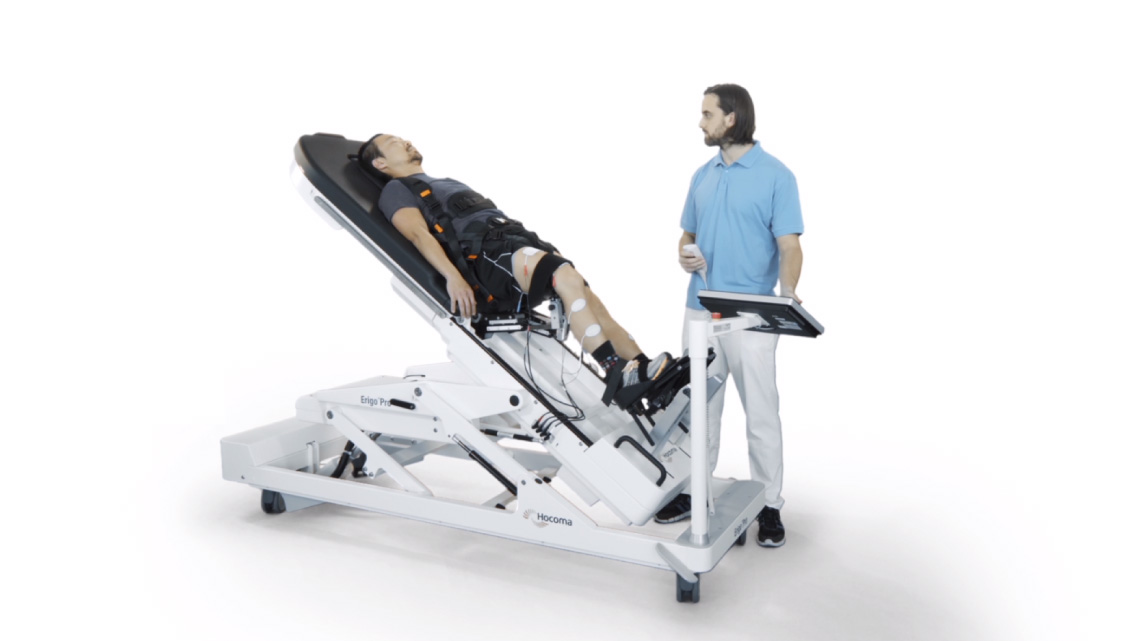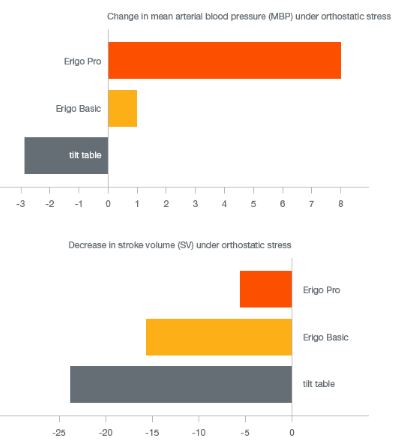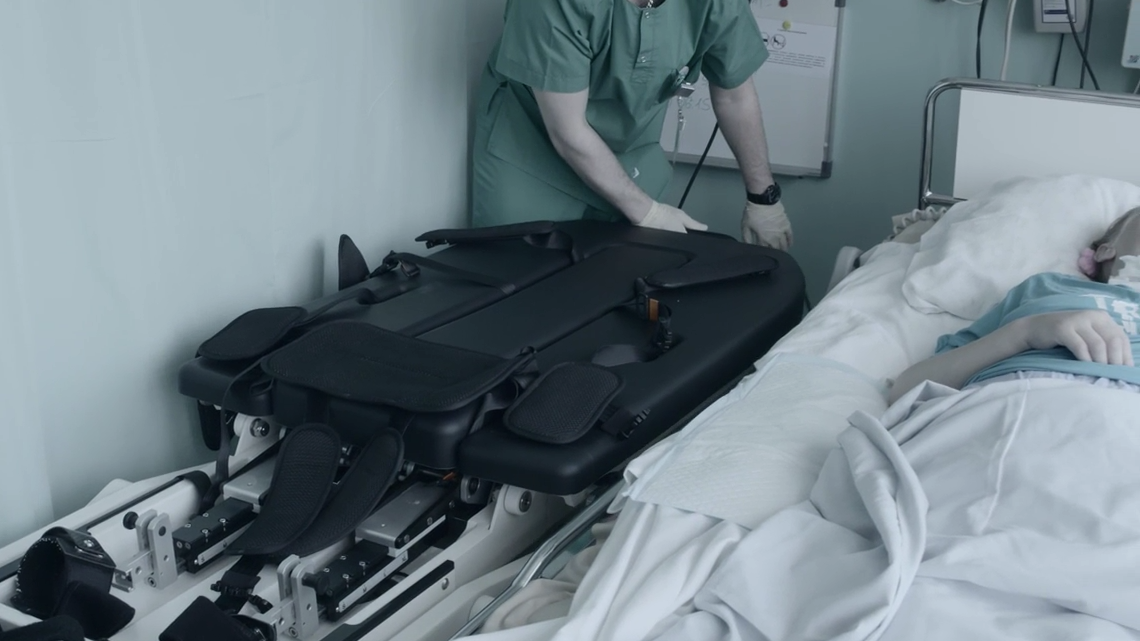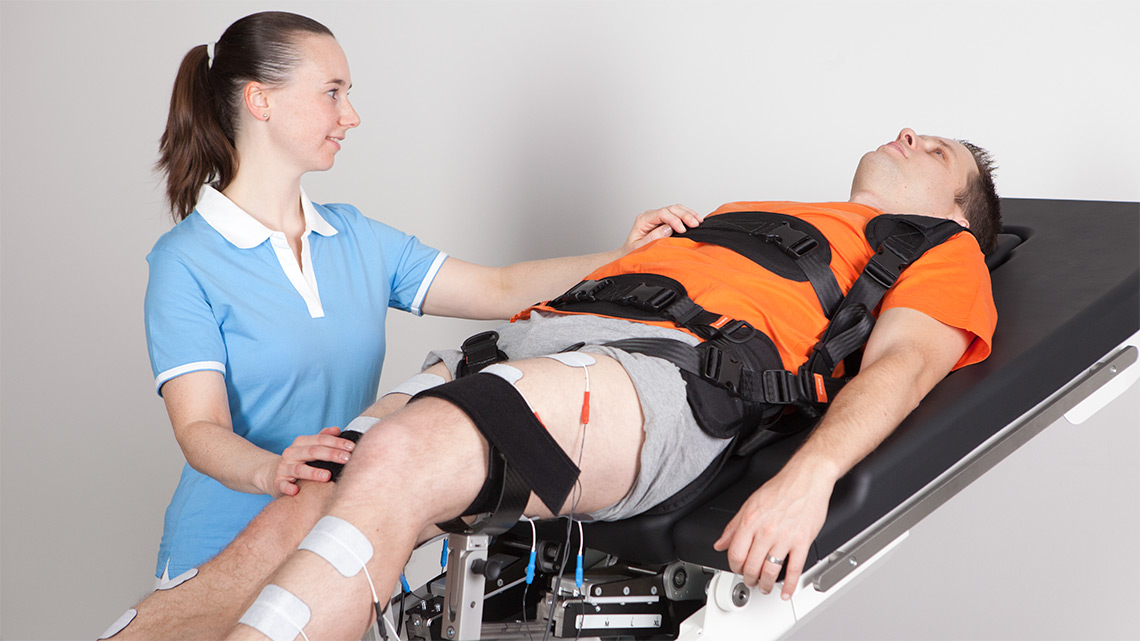Negative consequences of immobilization
Prolonged immobilization and reduced mobility have large consequences on the physical health status of the patient and can lead to various musculoskeletal and cardiovascular complications.
Research has also shown that immobilization in the early phase of and after acute medical treatment has a negative effect on the recovery process as well as long-term mortality rate. There is undisputedly a need for effective and safe mobilization from an early phase on, to reduce the direct as well as long-term immobility-related effects and complications.
Limitations of Conventional
Early Mobilization
Conventional Tilt Table Training
- No leg movement leads to limited musculoskeletal and cardiovascular response which can delay walking abilities in the acute period
- Pooling of blood in the lower extremities can lead to a drop of the central blood pressure
- Disruptions of therapy due to presyncopal symptoms
Conventional therapy – Out-of-bed
- Therapists are exposed to physical strain
- Standing up and early gait initiation are labor intensive
- Limited number of repetitions in an upright position
Advantages of ErigoPro Therapy
Early and Safe Mobilization
Safely verticalize and mobilize patients with very reduced or no ambulation ability and/or reduced transfer and standing abilities due to circulatory, neurological, or musculoskeletal conditions.
The ErigoPro gradually brings the patient into an upright position while moving the legs and applying cyclic leg loading. This enables safe verticalization and early functional mobilization of the lower extremity; optionally supported by functional electrical stimulation. Patients can be trained intensively and safely in a very early stage of rehabilitation.

Less disruptions of therapy
Therapy with the ErigoPro leads to significantly less disruptions of therapy than verticalization with a classic tilt table. (1)
Verticalization, passive leg movements and functional electrical stimulation may help in cardiovascular stabilization and reduce the risk of syncope.
(Hocoma data on file as of Nov. 2022)
Increased Muscle-Strength & Improved Functional Independence in Activities of Daily Living
Patients who are immobile in bed or in need of a wheelchair for mobility can increase their lower extremity muscle strength and achieve greater functional independence in activity of daily living with ErigoPro therapy. (1)
(1) Hocoma data on file as of Nov. 2022


FES supported muscle activation
Increases muscle activation by additional Functional Electrical Stimulation (FES).
Physiologically, leg muscle contractions (muscle pump) propel blood back to the heart, reducing venous stasis in the legs and stabilizing blood pressure. In patients who are immobile, FES-induced contractions of leg muscles could be used to activate the muscle pump and to improve blood flow and venous return.
The ErigoPro FES is fully synchronized with the robotic leg movements. Up to eight FES channels can be operated easily by the therapist on the touchscreen of the ErigoPro and adjusted according to the patient’s motor abilities.
Excellent Clinical Usability
The ErigoPro can be used stationary or rolled directly into the patient room. It can be adjusted to align with the patient bed for supine transfer or even transfer with a patient lift.
The ErigoPro offers a safe training with direct patient contact and the possibility of constant interact on with patients. Hospital equipment such as patient monitoring systems can be safely attached to the included standard rails. Further benefits include therapy control via an intuitive user interface on a touchscreen, electronic adjustment of leg length, as well as the flexible onesized patient harness system.


Increased Therapy Efficiency
The ErigoPro enables a single therapist to provide mobilization, verticalization, and sensorimotor stimulation safely and efficiently at the same time.
In specific cases, e.g., with acute patients, more than one therapist per patient may be necessary. In such settings, the efficiency may be increased further by installing more than one device in the same room.
Success Stories
Benefits of the Erigo®Pro are Recognized All Over the World
The therapy solution that uniquely combines gradual verticalization, leg mobilization and intensive sensorimotor stimulation through cyclic leg loading.
Scientific Evidence
- Early and Safe Mobilization
“The mobilization by means of Erigo is a well-tolerated method of mobilization and can be considered a safe system of early mobilization of patients with severe brain injuries.”
(Rocca et al. 2016)
- Less Disruptions of Therapy
“No episodes of marked hypotension were observed during verticalization on Erigo with or without FES. In contrast, more than half of the patients in the tilt-table group showed decreases in blood pressure of 20% or more.”
(Kuznetsov et al. 2013)
“Passive leg movements during head-up tilt [with Erigo] can lessen the number of treatment discontinuations due to presyncopal symptoms.”
- Improvement in Lower Extremity Muscle Strength
“In ROBO-FES [ErigoPro] leg strength increased more than in control [classic tilt table].“
(Kuznetsov et al. 2013)
- Improvement in Functional Independence in Activities of Daily Living
Verticalization and mobilization with the Erigo leads to a clinically relevant improvement in functional independence in activities of daily living in patients with very reduced or no ambulation ability and/or reduced transfer and standing abilities.
(Hocoma data on file, as of Nov. 2022)
What Experts Say
Improve Efficiency & Outcomes
Facilitates Entry Into Next Phase of Rehabilitation
Improves Efficiency in Mobilization
Excellent Clinical Usability
The Continuum of Gait Rehabilitation
Other products from Lower Extremities Solutions
Erigo®Pro
The only therapy solution that uniquely combines gradual verticalization, leg mobilization, and intensive sensorimotor stimulation through cyclic leg loading.
Learn More >Lokomat
Highly intensive rehabilitation to increase the strength of muscles and the range of motion of joints in order to improve walking.
Learn More >Andago
The Andago bridges the gap between treadmill-based gait training and free overground walking.
Learn More >









